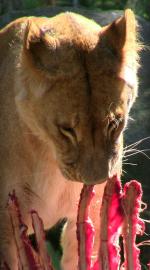Introduction
Lions in the wild and captivity

With an estimated population size of 20,000 individuals in Africa and a decreasing population trend in the wild, the International Union for Conservation of Nature (IUCN) lists the lion as ‘vulnerable’ (Bauer et al. 2016). Among the 37 recent felids lions are the only truly social-living cat species (Bradshaw 2016).
Lions reinforce group cohesion and individual bonds by social behaviours, such as allogrooming and head butting (Schaller 1972, Abell et al. 2013). After agonistic encounters within the pride social behaviour is displayed to mediate social tension (Packer & Pusey 1997, Packer et al. 2001). Common activities like hunting and patrolling are initiated by social behaviour (Schaller 1972, Matoba et al. 2013).
Wild-living lions are known to feed every 1.5 to 2.5 days and fast for up to 8 consecutive days (Eloff 1984, Altman et al. 2005). In general, wild-living lions are nocturnal and become active between 5 pm and 7 pm (Schaller 1972, Van Orsdol 1984). (...) Lack of hunting opportunities and onset of boredom in captivity can increase levels of inactivity and may lead to obesity, laziness, abnormal behaviour and, consequently, compromised welfare (Mallapur & Chellam 2002, Clubb & Vickery 2006, Altman et al. 2005, Powell 1995).
How lions are fed

The AZA (American Association of Zoos and Aquaria) recommends to feed large felids with meat on five days of the week, offer bones to gnaw on during the fasting day(s)(Lion Species Survival Plan 2012). Further the authors give an example for a weekly diet for lions without any fasting days and suggested to offer daily feeding enrichment. The EEP husbandry guidelines for Asiatic lions (Panthera leo persicus) state that the feeding “should be as varied as possible,(...) horse and/or beef, including bones, will constitute a major part of the diet, (...) rabbit and chicken should also be provided.” Furthermore, although wild-living lions feed together, the guidelines state to feed lions separately to “reduce the likelihood of fighting” (Dorman 2010).
These guidelines appear to be contradicting the Standards for the Accommodation and Care of Animals in Zoos and Aquaria by the EAZA (2014), which state that:
- Animals should be encouraged to engage in as much natural behaviour as possible.
- Special circumstances like fasting days/longer periods of fasting need to be considered.
- Natural feeding behaviours should be stimulated and feeding time should preferably last as long as in the wild.
- Social aspects should be considered when feeding.
In practice these four aspects of the Standards for the Accommodation and Care of Animals in Zoos and Aquaria are often not met (Clubb 2001).

However, experts emphasized that feeding should not be restricted to nutritional considerations but focus more on behavioural and psychological aspects of feeding (as reviewed by Kawata 2008). Surprisingly, there have been (...) no studies which focused on how feeding frequency influences behaviour of captive lions (Roe & Cleave 2005, Altman et al. 2005).
It was therefore the aim of the present study to assess how the behaviour and activity of lions kept on every other day feeding differs from the behaviour and activity of lions kept on a weekly feeding regime.
Responsible for this page:
Director of undergraduate studies Biology
Last updated:
05/20/17
